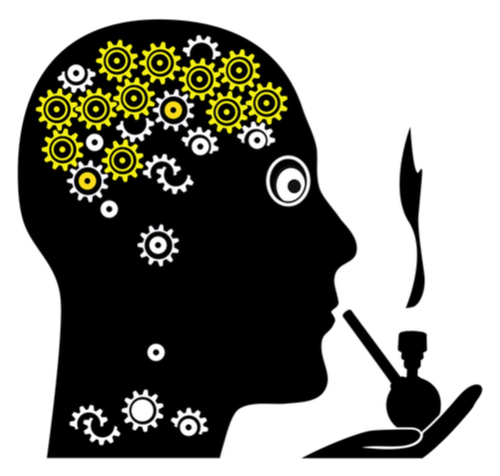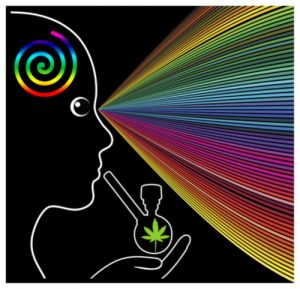Your Brain On Weed
Posted 7 years ago by Ian Shutts

While you have been enthusiastically puffing away on a joint, have you ever wondered exactly what is happening in your brain when you smoke weed? We have only recently begun to uncover the mystery of how cannabis interacts with the brain, and why humans have loved smoking weed for millenia.
The chemicals produced by the marijuana plant look a lot like some of the chemicals that are produced in our very own brains. This could be an explanation for why it feels so natural to smoke weed. When you have a little bit of an understanding how weed affects your brain, it’s easier to see how the phenomenon of the stoned effect occurs. From bursts of creativity to complete bouts of paranoia, this is your brain on weed!
The endocannabinoid system
First things first, it’s time for a crash course on the human body. One of the most important mechanisms of the human body is the endocannabinoid system. It is the elaborate connection of brain cells, nervous cells and immune cells that moderate the body’s natural healing, as well as for maintaining homeostasis. Homeostasis is the body’s balance or regulation. The endocannabinoid system is found in many different parts of the body, including organs, muscles and of course, the brain.
What this all means is that endocannabinoids can be found all over the body. These are cannabinoids that are produced naturally by the body rather than being ingested from outside. This means that when certain neurons are stimulated and producing cannabinoids, the effects can take place in the immune system, in muscles, pain regulation, mood and even appetite.
One of the biggest functions of the endocannabinoid system is that it is, essentially, the body’s natural healing system. When the body is injured or in pain, endocannabinoids are released to restore the balance once again. It is the body’s inherent intelligence which decides whether that means producing an anti-inflammatory effect, a pain relieving effect or to increase appetite.
The two main receptors located in the brain and body are CB1 receptors and CB2 receptors. While CB1 receptors are mainly located in the nervous system and organs, CB2 receptors are generally associated with the immune system. When one of these receptors is stimulated, an entire series of events takes place in the body (almost instantaneously) which produces any number of effects.
Some researchers even suggest that certain illnesses and mood related disorders are actually caused by a dysfunctional endocannabinoid system. Because ingesting cannabinoids from an external source can kick the endocannabinoid system into overdrive, marijuana can have an extremely healing effect for many people who use it.
The brain, THC and anandamide
There is an endocannabinoid that is produced in the brain that eerily resembles the famous cannabinoid in marijuana, THC. That endocannabinoid is called anandamide. It gets its name from the sanskrit word, ananda meaning bliss. So, it is rightfully called the bliss molecule. This endocannabinoid moderates brain functions such as memory, sleep, appetite and as its name suggests, mood.
So what happens when you ingest THC by smoking a blunt? You are essentially mimicking the brain’s naturally produced anandamide. This means that all kinds of neurons start firing much more rapidly than they usually would, causing an increased desire to sleep or eat. Smoking weed is often accompanied by a sense of euphoria or relaxation for this reason, too.
The brain is producing cannabinoids in a much smaller volume than what is being ingested through pot, which is why the feeling is exacerbated after smoking. Everything seems enhanced in some way – and that’s because it is! Your brain is essentially firing neurons at lightning speed when you are stoned compared to how your brain is behaving when you are sober.
Hyper-thinking and creativity

When you imagine all of these neurons firing at lightning speed in your brain, you can only imagine the effect that has on the user’s experience. Where neural pathways were once being created moderately slowly, and reaching their end pretty quickly, a stoned brain is working in the opposite way. Neural pathways are happening extremely fast and because receptors aren’t “switching off”, their end isn’t happening naturally.
What this means is that what starts off as watching a funny cat video turns into a complex web of thoughts and ideas about how to train your cat to jump through hoops. Every thought gains significant power, and what’s more, it is constantly following on to the next thought – and the next one, and the next one and so on.
This phenomenon of being stoned is perhaps what leads so many artists to creative outbursts when they are stoned. Somewhere in that web of ideas is the golden one that turns itself into a song or a painting or a movie script.
Now, having said all of that, this creative web of ideas is potentially also the reason that some people experience social anxieties or paranoia on marijuana. The sudden influx of information might make someone feel uncomfortable rather than creative, or even might make them afraid. It’s easy for some people to feel threatened by the increased activity that is taking place. That creative web can very easily turn into a destructive web.
None of this is “engraved in stone”. Every weed experience is different from the other, and everybody’s relationship with THC is highly individual. That’s why for some people, smoking weed is the greatest thing ever while for others, it’s their worst nightmare.
Your brain, weed and the long-term
We’ve talked about the immediate effects of smoking weed on the brain, but what about long-term effects? What we know simply about the short-term is only the beginning, and it’s exactly the same for long-term effects. Up until now, all of the scientific research about marijuana’s long term effects on the brain is speculation.
We know that marijuana affects parts of the brain that deal with memory, and for that reason some say that it can have a long term effect on your memory. However, most users report that whatever was happening to their short-term memory when they were stoners goes away when they stop using. And although marijuana has a long half-life in the body, there’s no real scientific evidence to suggest that it has permanent damage or effect on the brain.
Scientists are only just discovering the tip of the iceberg about how marijuana affects the human body and brain. What we know is so elementary that this magical plant is basically mystical to us. It’s also a mystery that one of the most widely used substances in the whole world remains hugely understudied and unknown.